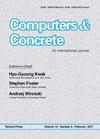Prediction model for concrete carbonation depth using gene expression programming
IF 3.3
4区 工程技术
Q2 COMPUTER SCIENCE, INTERDISCIPLINARY APPLICATIONS
引用次数: 10
Abstract
Concrete can lose its alkalinity by concrete carbonation causing steel corrosion. Thus, the determination of the carbonation depth is necessary. An empirical model is proposed in this research to predict the carbonation depth of concrete using Gene expression programming (GEP). The GEP model was trained and validated using a large and reliable database collected from the literature. The model was developed using the six parameters that predominantly control the carbonation depth of concrete including carbon dioxide CO2 concentration, relative humidity, water-to-cement ratio, maximum aggregate size, aggregate to binder ratio and carbonation period. The model was statistically evaluated and then compared to the Jiang et al. model. A parametric study was finally performed to check the proposed GEP model's sensitivity to the selected input parameters.基于基因表达式编程的混凝土碳化深度预测模型
混凝土碳化会使混凝土失去碱性,从而对钢产生腐蚀。因此,测定碳酸化深度是必要的。本文提出了一种利用基因表达程序(Gene expression programming, GEP)预测混凝土碳化深度的经验模型。GEP模型使用从文献中收集的大型可靠数据库进行训练和验证。该模型采用二氧化碳浓度、相对湿度、水灰比、最大骨料粒径、骨料与胶结料比和碳化期等6个主要控制混凝土碳化深度的参数建立。对模型进行统计评估,然后与Jiang等人的模型进行比较。最后进行了参数研究,以检验所提出的GEP模型对所选输入参数的敏感性。
本文章由计算机程序翻译,如有差异,请以英文原文为准。
求助全文
约1分钟内获得全文
求助全文
来源期刊

Computers and Concrete
工程技术-材料科学:表征与测试
CiteScore
8.60
自引率
7.30%
发文量
0
审稿时长
13.5 months
期刊介绍:
Computers and Concrete is An International Journal that focuses on the computer applications in be considered suitable for publication in the journal.
The journal covers the topics related to computational mechanics of concrete and modeling of concrete structures including
plasticity
fracture mechanics
creep
thermo-mechanics
dynamic effects
reliability and safety concepts
automated design procedures
stochastic mechanics
performance under extreme conditions.
 求助内容:
求助内容: 应助结果提醒方式:
应助结果提醒方式:


